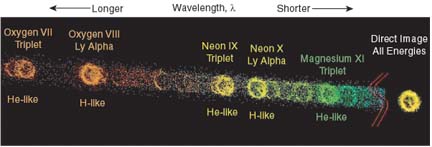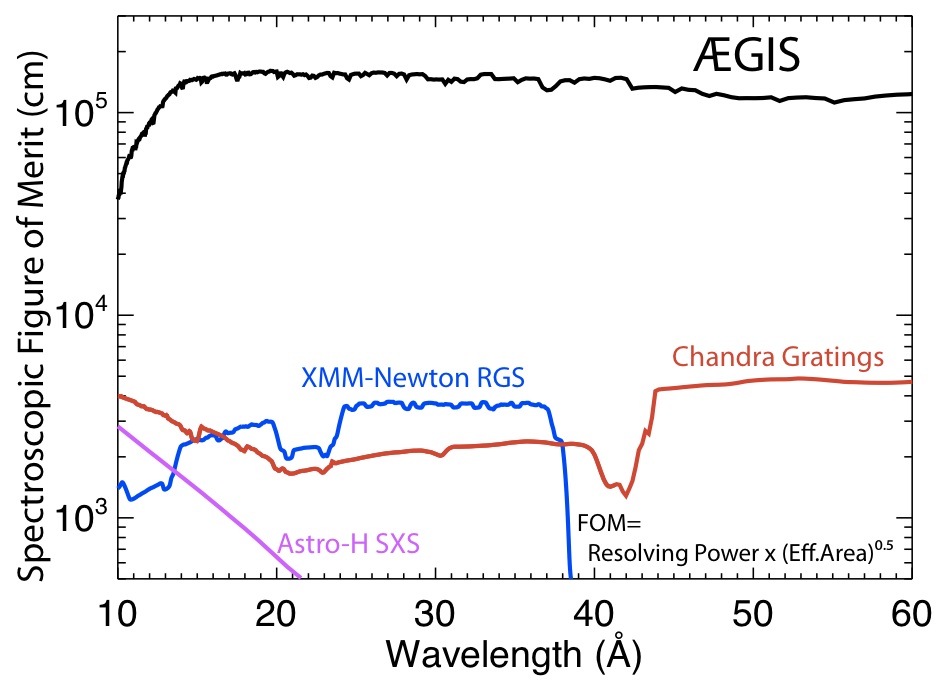While everyone at the SNL loves to develop new and unique devices, methods, and technologies, everything we do is driven by science questions.
Our focus is on high performance space instrumentation for x-ray astronomy and the physics of the magnetosphere and the sun, but technology developed along the way has also been used to address questions in other fields such as quantum mechanics (wave-particle duality), and to support the semiconductor industry (attenuated phase shift mask) and inertial confinement fusion (large-area laser pulse compression gratings).
X-ray Astronomy/High Energy Astrophysics
Celestial objects emit radiation across most of the electromagnetic spectrum. The intensity distribution of that radiation (broad continuum, sharp or broadened emission and absorption lines, etc.) reveals a wealth of information about the conditions and processes that give rise to the emissions. X rays are high energy photons (roughly 0.1 to 100 keV in energy) that are produced by some of the most volatile and energetic objects in the universe. Among those objects that can be studied with x-ray telescopes and spectrometers are supernovae, neutron stars, pulsars, magnetars, x-ray binaries, black holes, supermassive black holes (SMBH), quasars, relativistic jets, and accretion discs.

Credit: NASA/CXC/SAO/F.Seward et al.
Many astrophysics questions remain unanswered today, and x-ray astronomy can help address some very fundamental questions, such as
What happens close to a black hole?
Where are the missing baryons in the cosmic web?
How did supermassive black holes/active galactic nucleii (AGN) form?
How did the large-scale structure of our universe form?
How is the large-scale structure connected to AGN, or how does cosmic feedback work?
However, celestial x rays are absorbed by the earth’s atmosphere and can therefore only be studied with instrumentation in high-altitude balloons, sounding rockets, or orbiting satellites. X rays are relatively rare in space, and today’s orbiting x-ray telescopes are considered “photon-starved” and sometimes have to “count photons” for weeks at a time, looking at a single object. It is therefore imperative to build telescopes with larger collecting areas, but without unreasonable mass increases or unacceptable loss in angular resolution. The shaping and assembly of x-ray telescope mirrors is a present day challenge.

X-ray image of the supernova remnant E0102-72 in the Small Magellanic Cloud, dispersed by the HETGS.
In the soft x-ray band (~ 0.5-10 nm in wavelength) spectroscopy is best performed with an x-ray grating spectrometer (XGS). The best know examples are the High Energy Transmission Grating Spectrometer (HETGS) on NASA’s Chandra X-ray Observatory and the Reflection Grating Spectrometer (RGS) on ESA’s XMM-Newton Observatory.
We have recently developed a new type of soft x-ray diffraction grating – the so-called Critical-Angle Transmission (CAT) grating – that combines the advantages of both transmission and reflection gratings. A state-of-the-art XGS based on CAT gratings will open the door to a new discovery space with an improvement in figures-of-merit for emission and absorption line detection of at least an order of magnitude over existing instruments.

Figure of merit for the accuracy of line centroid (or velocity) measurements for AEGIS, the Chandra gratings, the XMM-Newton RGS, and the future Astro-H Soft X-ray Spectrometer (SXS).
The figure compares a spectroscopic figure of merit for the Astrophysics Experiment for Grating and Imaging Spectroscopy (AEGIS) mission concept to existing spectrometers and a future x-ray microcalorimeter for JAXA’s Astro-H mission on a semi-log plot, demonstrating the dramatic gain in performance. AEGIS is based on a CAT grating spectrometer.
It is designed to target science objectives concerning the large scale structure of the universe, cosmic feedback, interstellar and intergalactic media, and stellar accretion. Kinematics of galactic outflows, hot gas in galactic halos, black hole growth, the missing baryons in galaxies and the Warm Hot Intergalactic Medium, and the effect of x-ray radiation on protoplanetary disks all pose questions that will be addressed by a CATXGS-carrying mission.
More details about the science addressed by such a spectrometer can be found here, and spectrometer design is described here. A slightly smaller version of AEGIS is currently proposed as the Arcus mission. A much more powerful spectrometer could be flown on the Lynx mission, an x-ray telescope concept under study for the 2020 Astrophysics Decadal Review.
History of x-ray astronomy at MKI